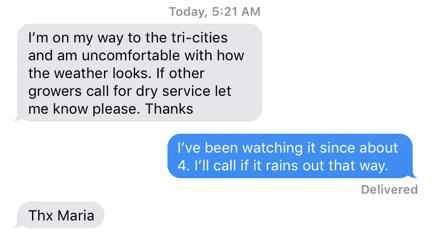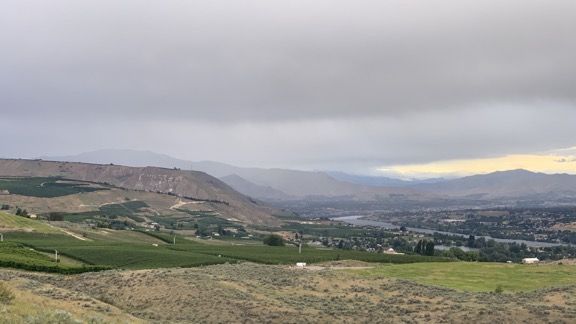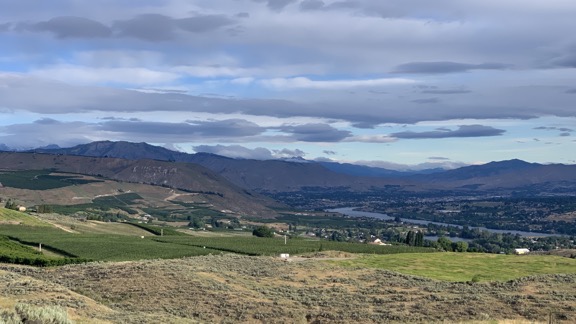Why relying on forecasts is a bad idea.
If you don’t know what cherry drying is all about, you can learn more in some of these older posts:
• Drying Cherries with the Big Fan (2006)
• Cherry Drying 101 (2008)
• The Story Behind Walking the Orchards (2008)
• I Dry Cherries (2008)
Heck, there’s too many to list. Just check out the cherry drying tag.
If you want to see me in action, check out these two videos on YouTube:
• Helicopter Cherry Drying – A Narrated Flight
• Cherry Drying with a Helicopter – Again
I’m deep into cherry drying season here in central Washington state. I’ve built a team of five pilots (including me) to cover about 400 acres of cherry trees in this area. We’re all on standby, which means we need to be around during daylight hours, ready to fly if it rains and we need to dry an orchard.
Standby is serious business. My contract with my growers says that I will have a helicopter in the air within 15 minutes of a call. To make that possible, I have to monitor the weather closely throughout the day and evening every single day. I use apps on my phone to get current radar information and the latest forecasts from at least two reliable sources (neither of which is The Weather Channel). And whether I’m home or out running errands, I’m always scanning the sky, noticing a build up of clouds. Even when I’m flying I have the radar layer displayed in Foreflight on my iPad, tracking the directional movement of cells.
I basically live the weather for 10 weeks every summer.
I Become a Weather Source
For good or bad, my clients have come to depend on me for this.
Years ago, I got a lifelong client when I called a grower at 6 AM on a Sunday morning to report rain on his orchard. It was a tough call to make; he was a newlywed living miles away down in town. There had been no rain in the forecast but rain had woken me in the middle of the night. I’d been camped nearby and when I went into the orchard to pick a few cherries for breakfast, I saw how wet the trees were. Do I call? It’s not my job. What do I do? I called. He launched me and drove out to the orchard to take a look. I was about 15 minutes into the job when he called me in the cockpit and said, “These trees are really wet. You probably saved our crop.” His 100+ acres in three different orchards makes up a good portion of my contracted acreage every year.
Last year, I was home doing some chores when I noticed a buildup of clouds out to the northeast, over the Waterville Plateau. That area, which is full of wheat fields, is prone to nasty thunderstorms every summer. There was nothing in the forecast for the two areas we service — Wenatchee/East Wenatchee/Malaga and Quincy — but I didn’t like the way this looked. I checked the radar. Sure enough, it was a big cell and it was moving south, right toward the orchard we service in Quincy. I got on the phone and called my guy based down there to ask what it looked like. He hesitated and then admitted that he was in Leavenworth, at least an hour away. There had been nothing in the forecast so he and his family had gone out for the day. While he hustled back, I called the grower. He lives in East Wenatchee and didn’t see the cloud build up. I told him what I saw on radar, and he headed down to Quincy for a look. Meanwhile, I prepared to fly in case my guy didn’t get back on time. I watched the cell move right on down to Quincy. A while later, the grower called back. The cell had dropped some rain on the far east end of his orchard — not enough to call the pilot out. Yes, it had been a false alarm, but he was glad I’d alerted him. And I think my pilot learned a valuable lesson about trusting forecasts.
I could tell stories like this half the day — after all, this is my twelfth season as a cherry drying pilot. But you get the idea. Forecasts simply can’t be relied upon.
Today’s Forecast
When I went to bed last night, there was no rain in the forecast. It was cloudy as I fell asleep, but I just assumed all that would move off during the night. Wrong. When I woke up just before 4 AM, it was still cloudy and unusually dark for that time of morning.
I checked the radar on my iPad as I do first thing every morning. I was surprised to see some light echos on radar. I’ve learned over the years that even that isn’t an indication of actual rain. Still, it put me on alert.

Here’s my early morning text exchange with a client. I really think they like getting a response within seconds when they contact me at odd hours.
So did the text I got from a client who had to leave town to manage picking at another orchard he owns 2 hours away. (Coincidentally, this is the same grower who told me I might have saved his crop a few years back.) Without someone there to check how wet his trees might get in a rain event, he was depending on adjacent growers’ decisions to launch pilots to launch me. I only had one other orchard near him that was on contract, but it was close enough to be a good indicator.

The radar image for the Wenatchee area at 5:55 AM this morning.
Around 6 AM, as I was having coffee, I was also watching the weather from my home. It’s perched up at the base of some cliffs, high up over the Wenatchee Valley and offers a 180° to 270° — depending on where you’re standing on my 10 acres — unobstructed view of the whole valley. It’s a perfect perch for someone doing what I do and makes a great base of operations for cherry drying services.
Here’s what I saw on radar and from my window.

Here’s the view from my deck when I captured the radar image above.
I started texting my crew. Of the three guys, Trevor responded within a minute. He gets it, I reminded myself. The other two: nothing.
Then I got a text from my friend Cyndi, who lives up on Wenatchee Heights. (Cyndi’s house was my starting point in this recent video: Flying Home from Taco Night.) “It’s raining!” She said. (It’s funny how many of my friends report rain to me throughout cherry season. I definitely appreciate it.)
I put Trevor on alert but didn’t send him to his helicopter yet. I tried to get the other one in the area, Ben, on the phone. I called once and it went to voicemail. I told him that if he had Do Not Disturb turned on, he should turn it off. Then I called again. It went to voicemail again and I told him that he was in trouble. Then I texted his boss, who was in Portland. Ironically, he responded immediately. I made sure he understood that I wasn’t happy about not being able to reach the pilot I was paying him to be able to reach 24/7. On call meant on call.
Time for a shameless plug…
If you like helicopters, you’ll love the FlyingMAir YouTube Channel. Check it out for everything from time-lapse annual inspections to cockpit POV autorotation practice to a flight home from a taco dinner at a friend’s house — and more.
The rain moved through the area southeast bound. I texted two of my clients to see how much rain they had. One texted back that the rain had been light but it was very windy. The other called with the same information. Cyndi reported the same thing. It looked like we could stand down. I texted Trevor.
It rained at my house. The wind was howling so hard that only half of my deck showed drops and they dried within seconds of hitting the ground. Then it was gone and only the wind remained.
It’s an hour after I took the photo shown above. The sun is out and there’s some blue sky. Radar shows a “wintery mix” over Mission Ridge, which is south of the orchards we have on contract. Even if we did have some more rain, I’m pretty sure this wind — which has been in the forecast for the past few days — would dry the trees.

It’s an hour later and the weather is clearing out.
This is what I do for 10 weeks every summer: play the weather game.
Discover more from An Eclectic Mind
Subscribe to get the latest posts sent to your email.

What do I think? That I definitely would not like to be the pilot you were unable to reach.
I finally heard from him. Says the sound was turned off on his phone. If it’s a new iPhone, I can definitely see that happening. My mute button gets accidentally switched so often that I’ve considered super-gluing it into position. But hell — if we had to fly and I couldn’t reach him I’d be in deep shit with my clients. This is the most stressful work I’ve ever done and at least 50% of the stress is due to the pilots I work with. It shouldn’t be that way.
I should add that this is the second strike against him. One more and he’s out.
I started flying over 30 years ago but local weather forecasts seem no more accurate now than then, despite huge advances in technology. When flying VFR fixed wing it is good to know if the wind will be within limits for the runways to be used; will it be raining or dry and will the cloud be above the minimum safety altitude? While ‘actual’ weather reports from local fields will be a good indicator of things to come, my general impression is that rain/ dry distinctions are little better than chance unless the probability given for rain is over 85%. Cloud minima tend to be too optimistic and wind speeds overly negative.
I have lost count of the number of trips I have cancelled because of forecasts which were wildly inaccurate.
But I suppose that the eternal truth:- “better safe than sorry” is especially pertinent in aviation.
I was most impressed by the accuracy of your forecasts for the cherry pilots. You are helped by lots of local ‘watchers’.
I was browsing around Trade-A-Plane and found Mr. Bleu up for sale (https://www.trade-a-plane.com/search?category_level1=Piston+Helicopters&make=ROBINSON&model=R44+RAVEN+II&listing_id=2361408&s-type=aircraft). Sounds like a big move… do you plan on making a blog post about it anytime soon!?
I’m actually having second thoughts about selling. I guess it all depends on whether someone is willing to buy at or near my price. You know what they say: everything is for sale if the price is right. If it sells, there will definitely be a blog post about my future plans. Until then, everything is changeable.